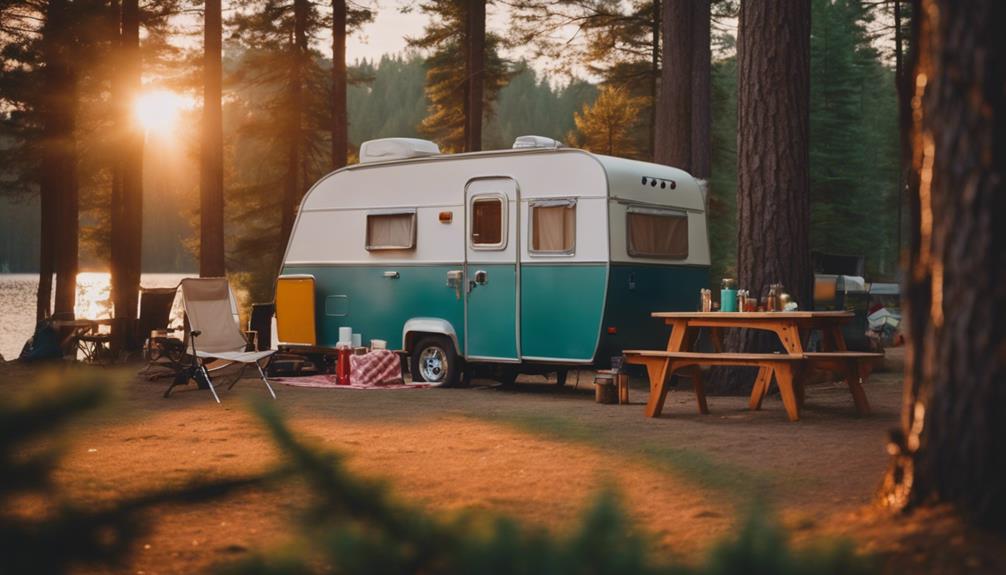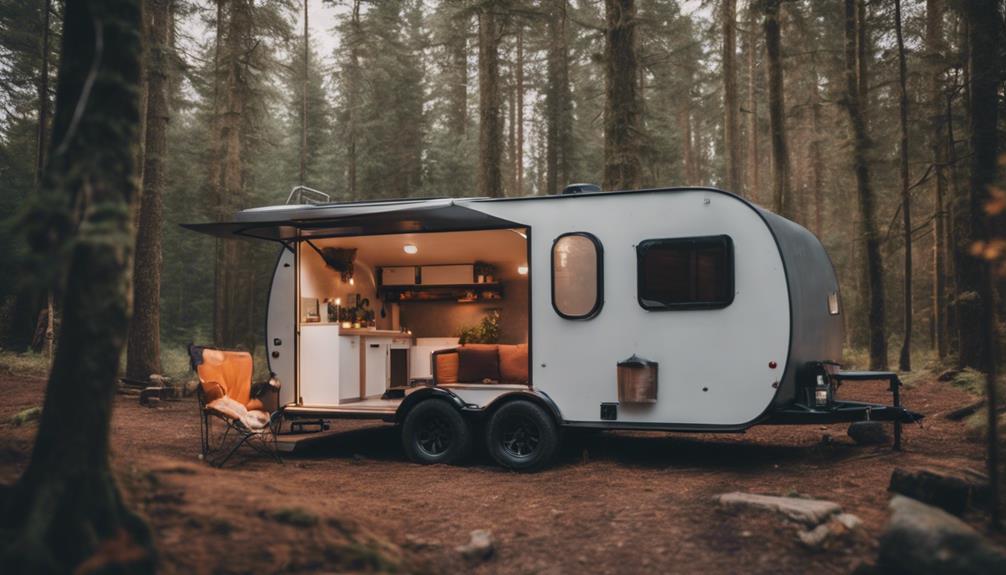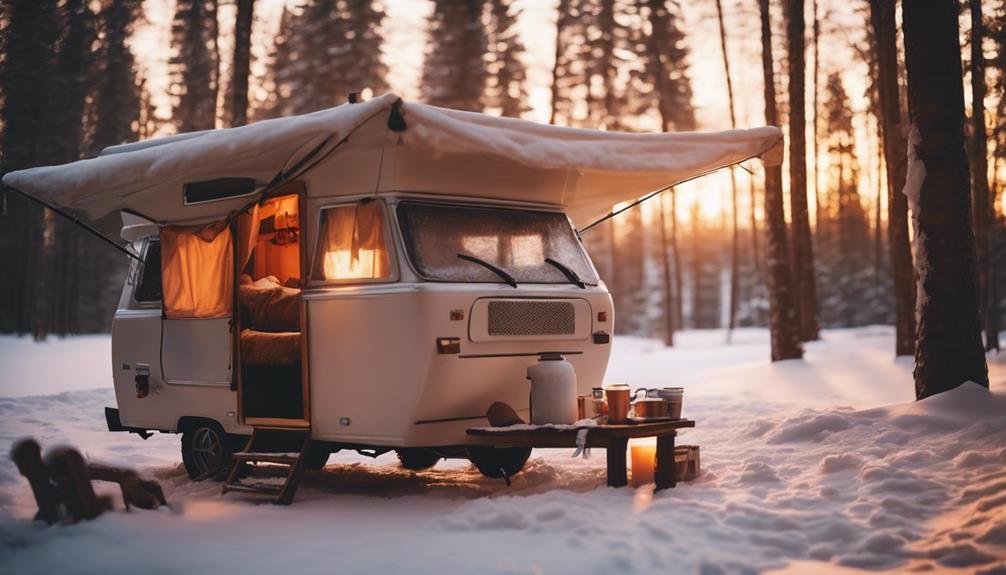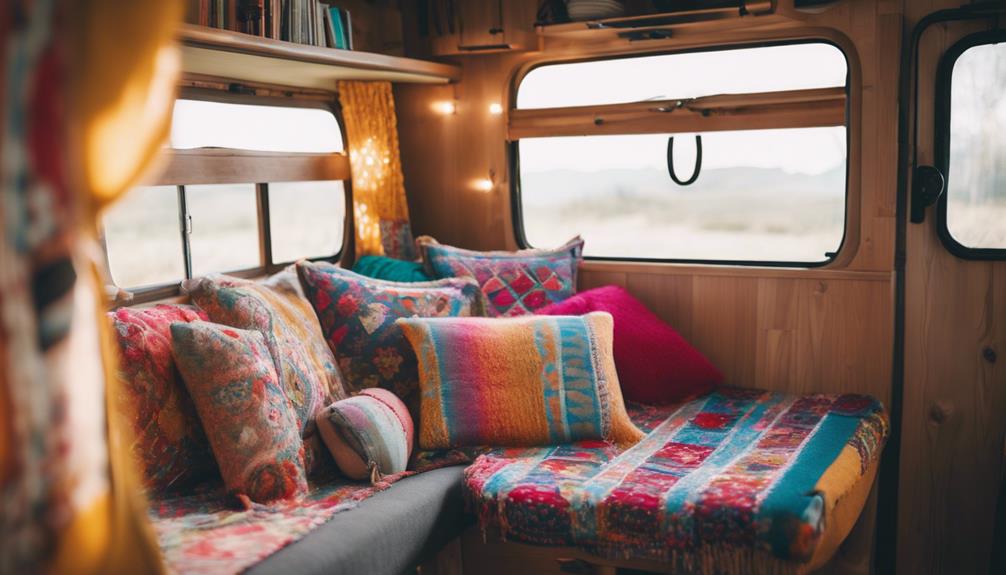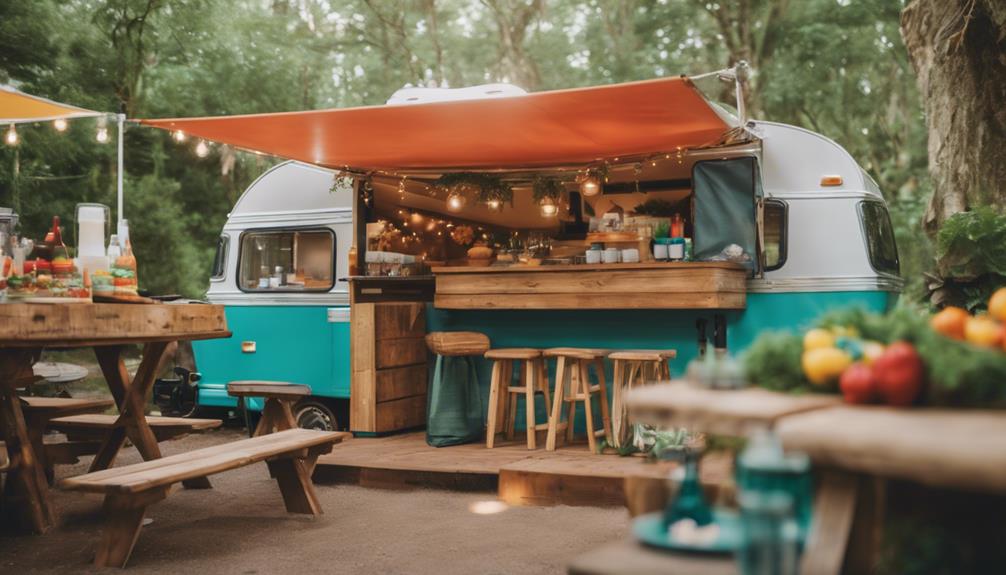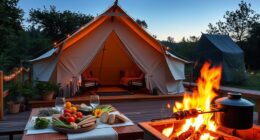Finding a used pop-up camper on a budget is all about strategy. Start by setting a clear budget that includes purchase and potential repair costs. Check online marketplaces like Craigslist or Facebook Marketplace for listings and filter by price. When you find a camper, inspect it for water damage and structural integrity. Confirm it meets your vehicle's towing capacity. Essential features to look for include enough sleeping space, kitchen amenities, and basic heating or cooling options. By following these tips, you'll navigate the market smartly and avoid common pitfalls. There's even more you can learn to confirm a great purchase.
Key Takeaways
- Set a clear budget that includes the purchase price, repairs, upgrades, and maintenance to avoid overspending.
- Utilize online marketplaces like Craigslist and Facebook Marketplace to find diverse, budget-friendly listings.
- Regularly check local classified ads for certified pre-owned options from reputable dealerships.
- Inspect for water damage, structural integrity, and ensure the camper's title matches the VIN before purchasing.
Key Purchasing Considerations
When buying a used pop-up camper, it's crucial to take into account several key factors to guarantee you make a smart investment. One of the most important things is to inspect for water damage. Look for signs like mold, musty smells, or damaged wood, as these can lead to costly repairs down the road.
Next, verify that the title matches the VIN and other identifying information on the camper. This step helps you avoid potential legal issues that could arise later.
Also, consider your vehicle's towing capacity before making a purchase. For instance, if you own a Honda Pilot, aim for a camper that weighs well under its 3,500 lbs limit.
It's wise to set a clear budget before you start shopping. Used pop-up campers can range from $500 to several thousand dollars, so factor in essential features and possible repair costs.
Essential Features to Look For
When you're shopping for a used pop-up camper, focus on must-have amenities that will make your trips enjoyable and comfortable.
You'll also want to take into account the size and weight of the camper to guarantee it fits your vehicle and camping style.
Keeping these factors in mind will help you find the perfect camper for your adventures.
Must-Have Amenities
Finding the right pop-up camper means prioritizing must-have amenities that guarantee comfort and convenience during your adventures. When you're on the hunt, focus on these essential features:
- Sleeping Space: Look for a camper with adequate sleeping capacity, ideally with multiple pull-out beds. This guarantees everyone in your family has a comfortable spot to rest after a day of activities.
- Kitchen Area: A functional kitchen area is vital for meal preparation. Make sure it has essential amenities like a propane stove, sink, and mini fridge. Having these features allows you to cook and store food conveniently.
- Storage Space: Adequate storage options are key for keeping your gear organized. Check for under-bed compartments and exterior weatherproof boxes to help you maximize your storage capabilities.
Additionally, consider amenities like heating or cooling systems if you plan on camping in various climates.
And if bathroom facilities are important to your camping style, make sure to evaluate that as well.
Prioritizing these must-have amenities will enhance your overall camping experience.
Size and Weight Considerations
How do you determine the right size and weight for your used pop-up camper to guarantee a safe and enjoyable camping experience?
Start by considering the total weight of the camper, including your gear and passengers. Make sure it falls within your vehicle's towing capacity, ideally exceeding the camper's weight by at least 500 lbs for safety.
When looking at size and weight considerations, larger pop-up campers often come with additional amenities like kitchenettes and bathroom facilities, which are great for families or extended trips. However, smaller models are typically more affordable and easier to tow.
Don't forget to assess the height and width of the camper when collapsed, ensuring it fits within your storage space and complies with local towing regulations.
Also, evaluate the sleeping capacity, which usually ranges from 4 to 8 people, to meet the needs of your travel group.
Finding Reliable Listings
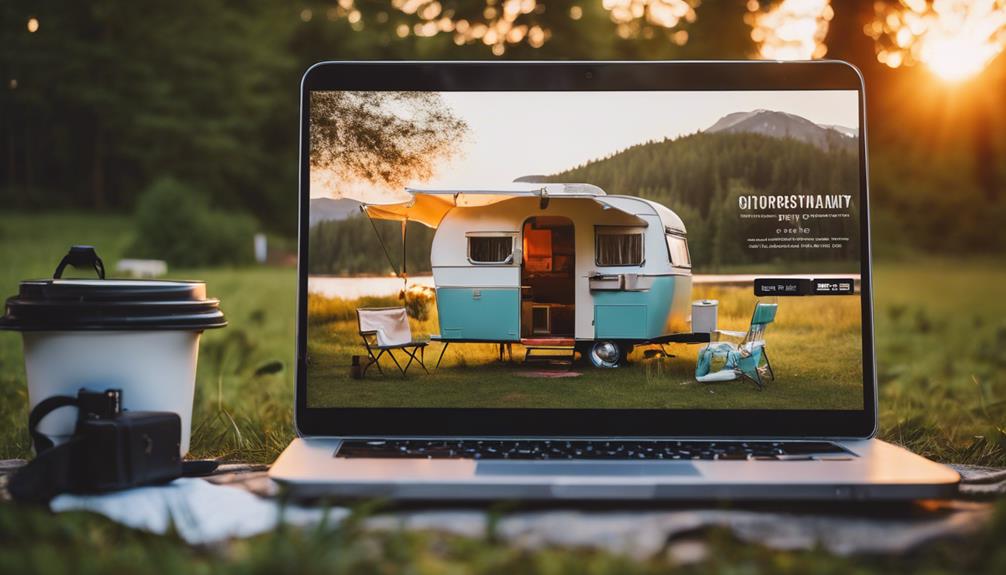
To find reliable listings for used pop-up campers, start by exploring online marketplaces like Craigslist and Facebook Marketplace, filtering your search by location and budget.
Don't forget to check local classified ads and reputable dealerships that might've certified pre-owned options.
Always inspect the camper in person before making any commitments to guarantee you're getting a good deal.
Utilize Online Marketplaces
Often, online marketplaces like Craigslist and Facebook Marketplace offer a diverse selection of used pop-up campers from both private sellers and dealers. When buying a used pop, it's important to know how to navigate these platforms effectively. Here are three tips to help you find reliable listings:
- Filter Your Search: Narrow down your results by location and price range. This helps you focus on options that fit your budget and are nearby for easier inspection.
- Review Listing Details: Carefully check each listing for essential information, such as the camper's age, condition, and amenities. Don't forget to note the seller's contact information for direct communication.
- Be Cautious: If a deal seems too good to be true, it probably is. Research the seller's reputation and request additional photos or information to verify the listing's legitimacy.
Additionally, consider joining online forums and community groups. These can provide valuable insights and recommendations on reliable sellers and popular camper brands.
Local Classified Ads
Local classified ads can be a goldmine for finding reliable listings of used pop-up campers in your area. Regularly check platforms like Craigslist and Facebook Marketplace, as listings can change quickly. Good deals often don't last long, so staying updated is vital. When browsing, use specific search terms like 'used pop-up camper' and filter results by location to find the most relevant options.
While local classified ads can offer great deals, it's important to be cautious of scams. Look for sellers with verified profiles and detailed descriptions. If a listing seems too good to be true, especially with prices markedly below market value, proceed with caution.
Don't hesitate to request photos that showcase the camper's interior and exterior from multiple angles. This step helps you gauge the condition before an in-person visit. Always ask for a complete setup and take-down demonstration to verify functionality.
Inspect Before Purchase
When you find a promising used pop-up camper listing, inspecting the camper thoroughly before making a purchase is essential to guarantee you're getting a reliable vehicle.
Here's what you should focus on during your inspection:
- Structural Integrity: Check for major issues like soft spots in the flooring and signs of water leak on the roof. This can indicate hidden damage that could lead to costly repairs.
- Lift System Functionality: Request a complete setup and take-down demonstration from the seller. This allows you to assess how smoothly the lift system operates, ensuring it's easy to use when you're out camping.
- Documentation Verification: Always confirm that the title matches the VIN and other details on the camper. This step is vital in avoiding potential legal issues and ensuring a smooth ownership transfer.
Make sure to schedule inspections during daylight hours for better visibility. Bring tools like a flashlight and moisture meter to help with your assessment.
Inspection Checklist Essentials
To guarantee you're making a wise investment, a thorough inspection checklist is essential for evaluating a used pop-up camper.
When inspecting a used pop-up, start by checking the roof for leaks and damage. Look for materials like aluminum and fiberglass and verify fresh caulk is present, as it's important to keep moisture out.
Next, evaluate the lift system; test its functionality and listen for unusual noises. Inspect the ropes for any signs of wear or tear—these can be red flags for future issues.
Examine the canvas for any perforations, stains, or mildew. Small holes can be patched easily, but larger ones might require costly replacements that exceed $1,000.
Don't forget to check the flooring and ceiling for soft spots, particularly in corners and around the air conditioning unit; these could signal underlying structural issues that need further investigation.
Lastly, test all electrical systems, including lights and appliances, to verify everything works properly. Make sure all plumbing fixtures operate without leaks.
Following this checklist will help you make an informed decision and avoid potential pitfalls.
Understanding Pricing Trends

When you're shopping for a used pop-up camper, you'll notice that prices can shift based on the season and your local market.
Typically, you'll find the best deals in the fall and winter months, while spring and summer prices can be higher.
It's important to compare local listings to get a realistic sense of what you should expect to pay.
Seasonal Pricing Variations
Understanding seasonal pricing variations is essential for finding the best deals on used pop-up campers, as prices typically drop during fall and winter months.
When you're buying a used pop, timing can greatly impact your budget. Here's what you should keep in mind:
- Fall and Winter Savings: Demand decreases in these seasons, leading to lower prices. Sellers are more keen to negotiate, making it an ideal time for budget shoppers.
- Spring and Summer Increases: As camping season approaches, prices usually rise due to heightened competition. You'll likely find fewer deals during these months.
- Sales Events: Look out for promotions during off-peak seasons. Sellers may offer discounts or be more open to negotiations to clear out inventory.
Local Market Comparisons
Local market comparisons can reveal significant pricing trends, helping you gauge the fair value of used pop-up campers in your area. Start by checking local listings on platforms like Craigslist, where you'll often find more accurate pricing than what's suggested by NADA Guides. These guides may undervalue certain models, leading you to miss out on a good deal.
When you compare prices of similar models, pay attention to seasonal fluctuations. Typically, prices dip in the fall and winter months due to decreased demand. This is an ideal time to scout for bargains, as smaller pop-up campers can be found for around $1,500 or less, while larger models with extra amenities may range from several thousand dollars.
Keep an eye on local auctions and sales events, as these can provide excellent opportunities to snag a camper at a lower price. By consistently monitoring your local market, you'll be better equipped to determine what's a fair deal and avoid overpaying.
Budgeting for Your Purchase
Establishing a clear budget is crucial for your used pop-up camper purchase, as it should include not just the purchase price but also potential repair and upgrade costs. These expenses can vary greatly based on the camper's age and condition. To guarantee effective budgeting, consider the following:
- Purchase Price: Research local market prices to set realistic expectations. Smaller campers often go for around $1500, while larger models with more amenities can run several thousand dollars.
- Repair and Upgrade Costs: Factor in any immediate repairs or upgrades you might need. Depending on the camper's state, this could range from minor fixes to considerable overhauls.
- Additional Expenses: Don't forget about registration fees, insurance, and maintenance costs that can add up over time.
Community Resources for Buyers
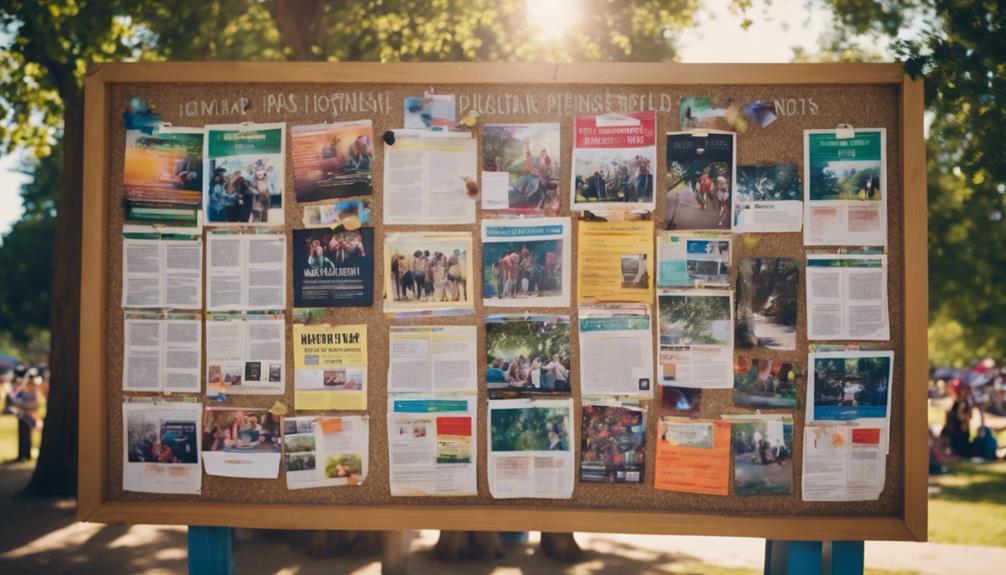
After setting your budget, tapping into community resources can greatly enhance your search for the perfect used pop-up camper. Online platforms like PopUpPortal.com offer valuable manuals and forums where you can connect with fellow enthusiasts. These resources help you gain insights into what to look for in a camper.
You might also want to join the RVFTA Facebook Group. This active community allows you to ask questions and receive advice from experienced campers who've been through the buying process. Additionally, numerous podcasts focus on RV and camping topics, providing practical tips from seasoned campers to help you make informed decisions.
Don't forget to engage with local camping and RV clubs in your area. These networks can lead to recommendations and insider tips on used pop-up campers available nearby.
As you explore your options, having a checklist for inspections will guarantee you systematically evaluate potential campers and catch any critical issues before making a purchase.
Common Buyer Mistakes
Many buyers make vital mistakes when shopping for a used pop-up camper that can lead to expensive regrets down the road. Here are three common buyer mistakes to avoid:
- Neglecting the Title Check: Always verify the camper's title against the VIN. This significant step prevents ownership disputes or unexpected legal issues that could arise later.
- Overlooking Inspections: Failing to thoroughly inspect the camper's condition can be costly. Check for structural integrity and potential water damage. Ignoring these aspects might lead to expensive repairs soon after your purchase.
- Ignoring Towing Capacity: It's essential to confirm your vehicle can safely tow the used pop. Overlooking your vehicle's towing capacity can result in unsafe towing situations, putting you and your family at risk.
Additionally, set a realistic budget that includes potential repair costs and necessary upgrades.
Rushing into a purchase without researching the camper model can lead you to buy a unit that doesn't meet your camping needs.
Being aware of these common buyer mistakes will help you make a more informed decision and guarantee a satisfying camper experience.
Maintenance Tips for Campers
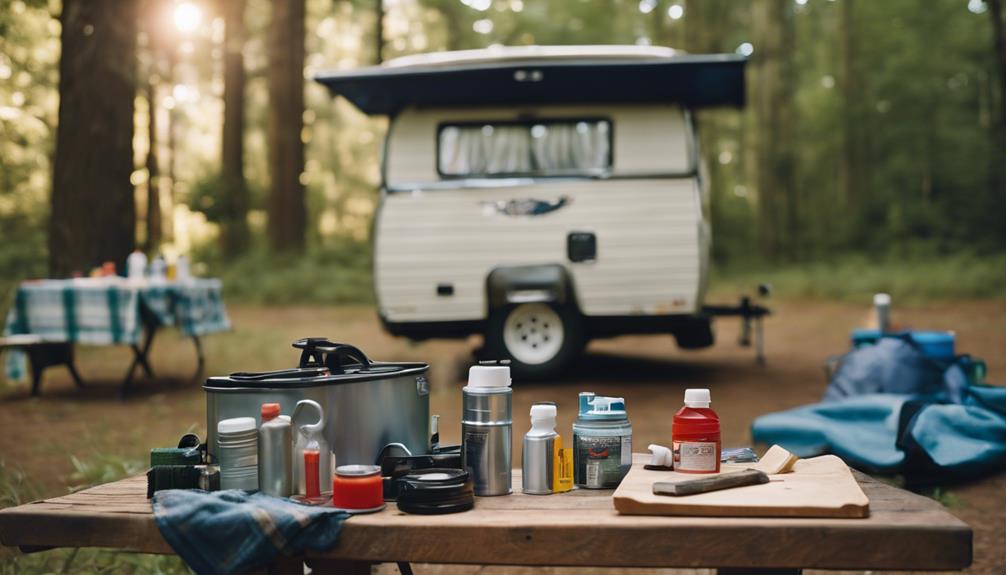
Regular maintenance is key to keeping your used pop-up camper in excellent condition and guaranteeing a worry-free camping experience.
Start by inspecting the roof regularly for leaks, paying close attention to seams and corners. Water damage can lead to extensive repairs if you don't address issues promptly.
Next, check the lift system for wear and tear. Test its functionality to verify it raises and lowers smoothly without any unusual noises, which could signal maintenance issues.
Your camper's tires also deserve attention; assess them for proper inflation and tread depth to confirm safe towing and performance.
Don't overlook the electrical systems either. Perform routine checks on lights and appliances to validate everything's functioning correctly, preventing potential electrical failures when you're out camping.
Preparing for a Successful Inspection
Preparing for an inspection of a used pop-up camper requires careful planning and the right tools to guarantee you don't miss any essential details. Before diving into the inspection, here are three key things you should consider:
- Gather Your Tools: Bring a flashlight, screwdrivers, and a moisture meter. These tools help you check for hidden issues and assess the camper's condition thoroughly.
- Research the Model: Familiarize yourself with the specific model and year of the camper. Knowing common problems can help you focus on significant areas during your inspection.
- Schedule Wisely: Choose to inspect during daylight hours. Good lighting will help you spot potential issues easily.
When buying a used pop, it's vital to test everything. Check the mechanical functionality, structural integrity, and interior conditions.
Don't forget to bring a detailed checklist to cover all aspects. Additionally, reviewing the seller's maintenance history beforehand allows you to understand the camper's usage and any prior repairs.
This preparation will lead to a more informed decision and a successful inspection.
Frequently Asked Questions
How to Inspect a Used Pop-Up Camper?
When you inspect a used pop-up camper, check the roof for leaks, test the lift system, examine the canvas for damage, and assess the floor and ceiling for soft spots. Don't forget to test the electrical systems!
What Time of Year Is Best to Buy a Pop-Up Camper?
Did you know that prices drop by up to 30% in fall? To snag the best deal on a pop-up camper, shop during late summer or fall when sellers are keen to sell before the off-season.
What Is the Life Expectancy of a Pop-Up Camper?
A pop-up camper typically lasts 10 to 15 years, but with proper maintenance and care, you might see it last over 20 years. High-quality brands and timely repairs can greatly boost its lifespan.
How Do I Find Out How Much My Pop-Up Camper Is Worth?
As you ponder your pop-up camper's worth, consider checking NADA Guides for baseline values, comparing local listings, and evaluating its condition. Seasonal demand affects prices too, so timing your sale can maximize your return.
Conclusion
Finding a used pop-up camper can be an exciting adventure.
By knowing what to look for, understanding pricing trends, and avoiding common mistakes, you'll make a smart purchase.
Remember to check reliable listings, inspect thoroughly, and consider maintenance needs.
With the right preparation and community resources at your fingertips, you'll not only find a camper that fits your budget but also one that fits your lifestyle.
So get out there, explore your options, and enjoy the journey!

